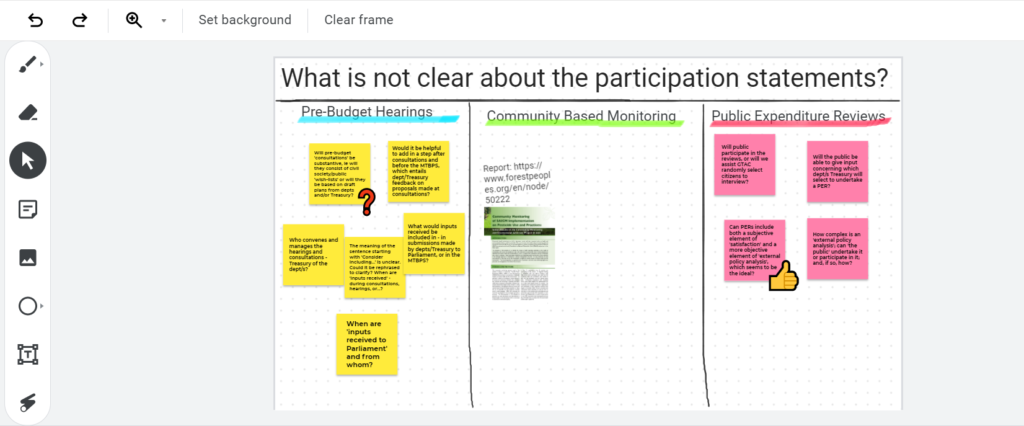Mar 30, 2021
If you have ever attended an International Budget Partnership (IBP) in-person training, chances are you scribbled some thoughts on tiny sticky notes and stuck them on flip charts around the room. We at IBP love our flip charts, color markers and sticky notes. We haul them with us on long flights to all locations far and near.
You see, many IBP colleagues have been trained in designing workshops based on a learning-centered approach. This approach views adult learners as bringing their own knowledge, experiences and ideas which helps ensure the learning is personal and meaningful. Getting participants to think independently or collaborate in small groups is part of every learning event, as it deepens engagement with the content and others in the room.
Flip charts, colorful notes, markers and pens are the means to an end: learning.
In light of the new world order, we are working to engage learners for the same outcomes but in virtual spaces. One helpful tool to engage people in their learning is Jamboard.
What is Jamboard?
Jamboard is a cloud-based whiteboard offered by Google. It is similar to Microsoft’s Whiteboard, Evernote or Miro (see GLP blog Miro is a Digital Whiteboard).
For anyone having a Gmail account, Jamboard is connected to your Google Drive. Just go to ‘jamboard.google.com’ in the web browser. An App is available for download as well. Yup, it is that easy.

Features of Jamboard
Jamboard has much to offer. Here are a few features I especially appreciate:
- Offers anonymity. Individuals can post ideas, wonderings, questions and work without a name attached. This can help people share more freely and openly.
- Invites brainstorming and ‘blue sky’ thinking. Because it is anonymous and ideas can easily be changed or erased, ‘draft thinking’ happens easily.
- Downloads the slides into pdf or png images for easy sharing. Jamboard slides remain in the host’s Google drive account and participants with the link can view the slides online as long as the host maintains the original.
- Allows you to upload images, icons, and other types of text. Participants can link to their own pictures on the desktop or on their personal Google drive.
- Allows you to resize, drag and rotate images. There is much potential for using images beside written text.
Using Jamboard
Here are some ideas for using Jamboard:
- One of the best ways for collaborating is to brainstorm in small groups. Breakout rooms offer this opportunity virtually. The hosts can share the link to the Jamboard in chat, with preloaded slides. It would be simplest to correlate slide numbers to the breakout room number. The host may choose to write the name of participants on the slide. One advantage of using Jamboard as opposed to shared Google Docs is that the page does not move every time a participant writes (which can be frustrating).
- Brainstorming. Jamboard is perfect for brainstorming, because everyone can get into the common space and write. Then you can erase duplicates, cluster ideas, tag clusters and discuss the relationship between the clusters. This is a wonderful way to keep energy and engagement up for the entire group – all hands-on deck!
- Idea clustering. Moving the ideas around is easy and satisfying. As you cluster it is also easy to make the sticky notes bigger or smaller, as space allows while you cluster.
- Group organizing. Giving the clustered ideas a title is also easy and helpful. Remember when we used to stand with a group in front of large wall, posting ideas, moving them around and taping titles to the groups – this is even easier!
- Debriefing. Jamboard allows you to collect ‘likes’ and ‘suggestions’ after an event or gathering. In 10 minutes, a group of 2-10 (or more!) can offer feedback in Jamboard to be discussed in breakout groups or together as a whole group. It’s so satisfying.
- Planning. Jamboard also offers a helpful space to name all the action items a team needs to address. It’s fast and fun, and offers a common space to add and refer to.
- Sharing and reporting. In breakout groups, teams can share highlights of a project. After each group has populated their own Jamboard slide, groups can visit each other’s slides. They can leave comments, questions, or you can bring final thoughts to the large group.
What I love most about Jamboard is that it is easy to learn and easy to teach. We are all learning tons of new technology, learning platforms, and virtual tools – the learning curve continues. I promise that this one is worth it.
What tools have you discovered lately and find helpful?
* * * * *
Suad Hasan is a Program Officer for the Open Budget Initiative at International Budget Partnership. She is responsible for data collection and analysis for the Asia region of the Open Budget Survey, as well as facilitating trainings, support to IBP partners, in-country peer reviewers, and government officials throughout the Survey process. Suad holds a Masters in International Relations from American University, with a focus on International Economics.
Read other blog posts from the IBP team here.
Other GLP blogs connected to this topic are:
- Miro as a Digital Whiteboard
- Using PowerPoint as a Learning Tool
- Quizzes and Polls
- How to Use the Chat Box, Respectfully



